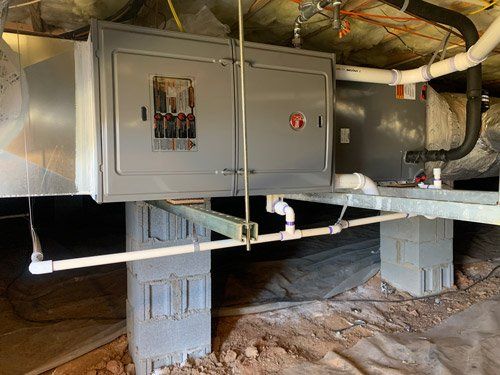The Ultimate Overview to Heating System Installation for a Cozy Home
Heater setup is a crucial aspect of keeping a comfortable home environment, specifically during the cooler months. Comprehending the various kinds of heating systems available and the value of choosing the appropriate dimension can significantly influence both effectiveness and convenience levels. Moreover, a detailed setup procedure, matched by the right devices and materials, makes certain ideal efficiency. This guide intends to equip house owners with the knowledge needed to make enlightened decisions and carry out reliable maintenance methods. As you take into consideration these elements, the inquiry remains: what steps can you take to guarantee your heater serves you well for many years ahead?
Sorts Of Furnaces
When thinking about heating system installment, recognizing the various types of furnaces available is essential for making an educated choice. The key sorts of furnaces include gas, electric, and oil furnaces, each offering distinct advantages and considerations.
Gas furnaces are the most common choice because of their effectiveness and lower operational expenses. They utilize gas or propane, offering quick heating and consistent efficiency, making them ideal for colder environments.
Electric heaters, while usually less complicated to mount and keep, often tend to have greater operational costs. They are often favored in locations where gas solution is not available or for homes with existing electric infrastructure.
Oil heaters, though much less typical today, remain a viable option in particular areas. They burn heating oil, which can be useful throughout colder months, but their dependence on oil shipment poses potential obstacles.
Furthermore, there are high-efficiency designs available throughout these kinds, which can considerably lower power usage and energy expenses. Ultimately, recognizing these heating system types will certainly help homeowners select a system that aligns with their home heating needs, spending plan, and energy choices.
Selecting the Right Size
Selecting the suitable dimension for a heater is essential to guaranteeing ideal performance and power effectiveness. A small heater will certainly struggle to maintain comfortable temperatures during the cold months, resulting in enhanced deterioration, higher energy expenses, and prospective system failure. On the other hand, a large heating system might cycle on and off as well often, leading to inefficient heating and unequal temperature distribution within the home.

Heater dimensions are normally gauged in British Thermal Units (BTUs), which indicate the quantity of energy required to warm a space. It is advisable to speak with a certified a/c specialist who can execute the needed calculations and suggest a suitably sized unit. furnace repair. Purchasing the appropriate furnace size not just boosts comfort however additionally contributes to long-term power financial savings and system reliability
Setup Refine Review
When the ideal furnace why not look here size has been figured out, the following action involves understanding the setup procedure. This procedure generally begins with a detailed assessment of the installation site, including the existing ductwork and ventilation systems. Appropriate planning is necessary to ensure seamless Read Full Article assimilation and ideal performance of the brand-new heater.
The setup generally consists of detaching the old unit, which includes securely removing any kind of electrical connections, gas lines, and ductwork connected to the previous furnace - furnace repair. As soon as removed, the brand-new furnace is carefully located and leveled, guaranteeing that it satisfies the supplier's specs for optimal operation
Next, the installer will link the needed gas and electrical lines, adhering to regional codes and security laws. Following this, ductwork may need to be changed or replaced to suit the new system, guaranteeing efficient air movement throughout the home.

Important Tools and Products
Gathering the crucial devices and products is essential for a successful heating system installment. Correct prep work guarantees that the installation process is reliable and decreases the capacity for mistakes.
Trick devices needed consist of a drill, screwdrivers, wrenches, pliers, and a degree. A multimeter is important for electrical connections, while a pipeline cutter and flexible wrench are required for gas line installment. Additionally, a measuring tape and a stud finder will help in making certain accurate positioning and safe and secure fastening of the furnace.
In terms of products, you will require ductwork, insulation, and securing tape to guarantee ideal air movement and energy performance. It is also vital to have a brand-new heating system filter available, along with venting products, such as PVC pipeline or metal flue, relying on the kind of heating system being installed.
Safety and security tools, including gloves, goggles, and a face mask, is likewise important to protect versus dust and particles throughout setup. Having all these tools and products conveniently offered not only simplifies the procedure yet also improves the safety and security and efficiency of the heater installment.
Maintenance Tips for Longevity
To guarantee the long life of your furnace, it is necessary to apply a routine maintenance timetable that resolves essential components of the system. Begin by changing or cleaning up the air filter each to 3 months, as a stopped up filter can restrict air flow and reduce performance. Additionally, examine and cleanse the blower assembly to stop dirt build-up that can prevent efficiency.
Following, check the thermostat settings and recalibrate if essential to make sure accurate temperature regulation. Evaluate the ductwork for leakages or blockages, as this can bring about power loss and irregular home heating. Consistently oil the motor and bearings according to the manufacturer's referrals to reduce damage.
Professional assessments need to happen each year, where a certified technician can analyze the furnace's general condition, look for gas leaks, and make certain that safety features are working correctly. Consider mounting a programmable thermostat to maximize power usage and keep regular home temperatures. By taking on these upkeep practices, you can improve your heating system's effectiveness, extend its lifespan, and ultimately appreciate a cozy and comfortable home atmosphere.
Final Thought
Efficient heating system setup is vital for attaining ideal home comfort and power performance. Recognizing various heating system kinds and selecting the proper dimension makes sure correct functionality.